Crossing the Mona Passage: How to do it Safely.
Crossing the Mona Passage can be done safely and with minimum stress, which is the goal for our family. Let me share how to plan for a successful Mona crossing.
It is a passage with quite some literature dedicated to it, instilling fear in the hearts of sailors with tales of high seas, angry waves and turbulent waters fueled by strong winds!
Yet, if you find yourself in the amazing Dominican Republic, headed to Puerto Rico – you will have to cross the Mona Passage.
Is there another way, to avoid crossing the Mona Passage?
To be fair, there is a much calmer and more pleasant route to take, going with the wind, or the so called downwind sailing, and not risking boat or crew damage.
That route calls for sailing west, via Haiti, along the south coast of the Dominican Republic and, finally, crossing over to Puerto Rico in a much more pleasant manner, leaving the northern Mona Passage in those tales of old, where it belongs!
This is a much longer route and not everyone is eager to sail in Haiti.
That route was not what we were preparing for. With only a couple of weeks left, before we would have to pay around $200 more to extend our stay, the window to leave the DR was slowly closing for us! So, Joe plotted our course across the Mona and we prepared to sail off.
What is the Mona Passage?
The Mona passage is the strain between the Dominican Republic and Puerto Rico. It is around 80 miles long. It also connects the Atlantic ocean with the Caribbean Sea and is an important connecting point in terms of trade and shipping.
Crossing the Mona Passage will most likely increase the distance of the route, because the boat needs to avoid certain areas in the passage, for a better and safer crossing.
How to Cross the Mona Passage Safely
Just like many other stories of scary waters, the Mona is a physics puzzle, which, if solved correctly, presents no greater risks to sailors, than any other body of water.
Thankfully, Joe was good at solving puzzles, so he created a diagram of the predicted wind angles and our route, in order to make the passage more tolerable and even sail, if possible.
As it turned out, we were able to sail for around half of the Mona crossing, since we had waited for the wind to shift from the northeast, rather than its usual east-to-west direction. It might take some waiting for the right wind, if you plan to sail and not motor or tack the entire time.
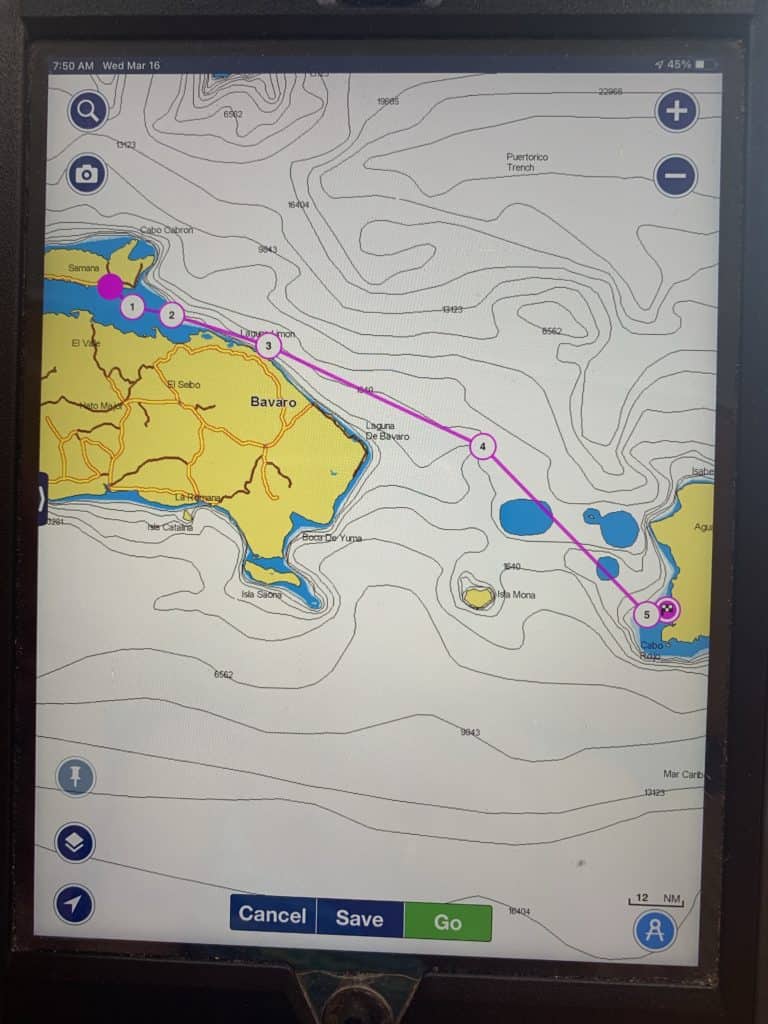
What to avoid in crossing the Mona Passage?
You should try to avoid the shoaling off the coast of DR, which is an hour-glass shaped area, where depth sharply decreases, creating more turbulent waters to navigate.
Joe’s plotting took into effect the wind speed, the wind direction and the shoaling. We also considered the waves’ height and period, so even though there were going to be taller waves, around 1.5-2 meters, they were predicted to be spaced apart every 7 seconds, or so.
We only trust our wind app so much, but overall that time it turned out to be correct and helped us follow the plotted angles like a textbook.
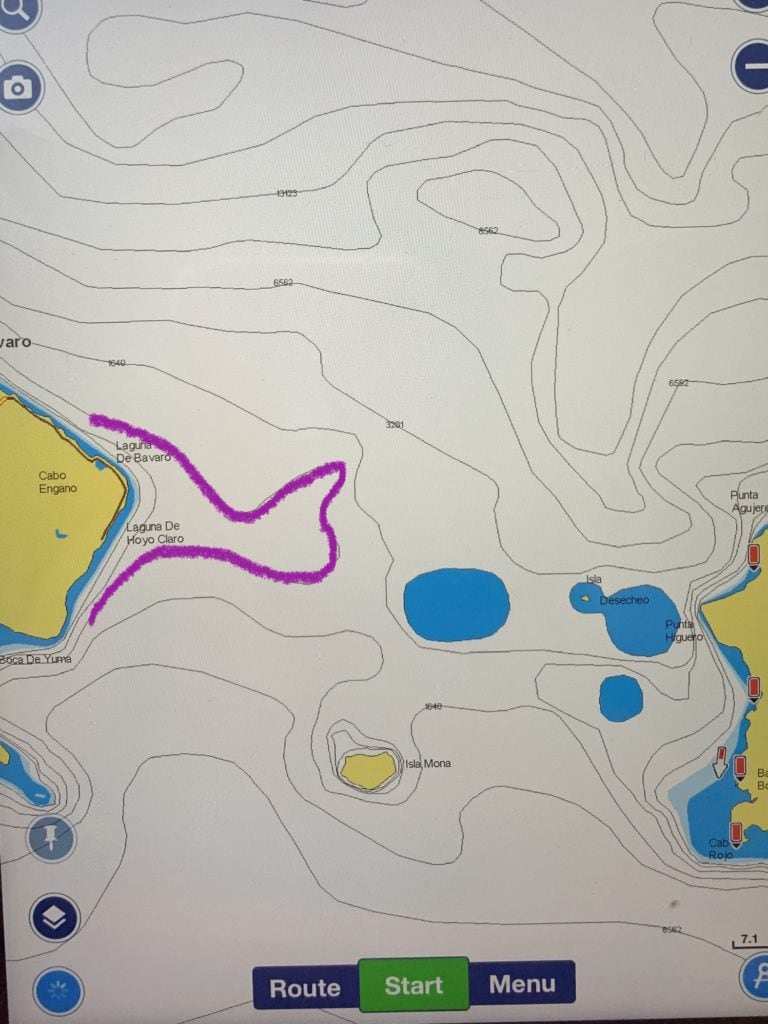
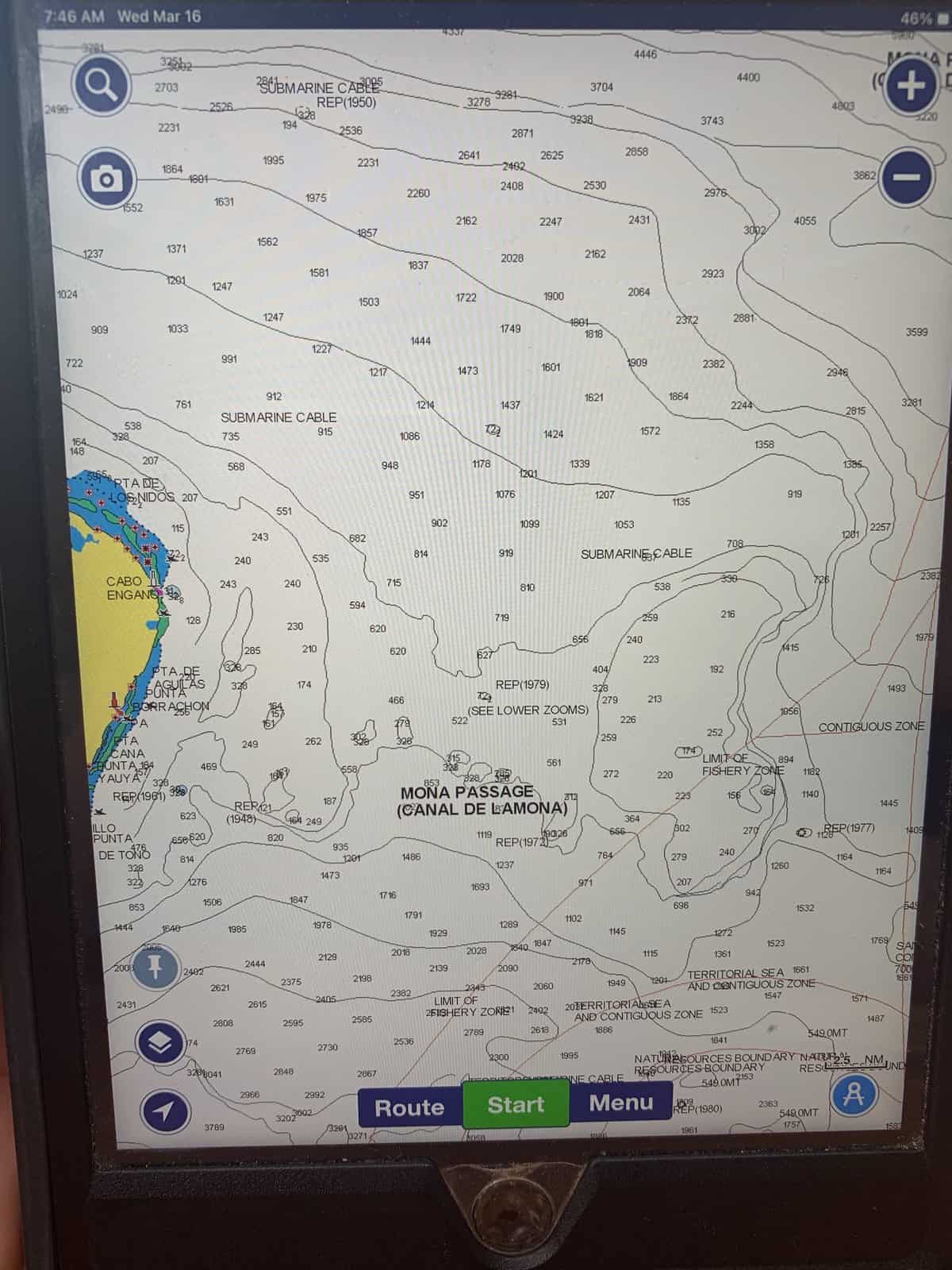
When to leave the Dominican Republic and cross the Mona
There are a few more things to consider, while choosing the best time to leave the Dominican Republic:
- Time of arrival – it is best to arrive at a new destination in the morning.
- “Despacho” limiting departure from Samana between 06:00 and 18:00.
- Saturday and Sunday are days off. Prepare your paperwork on Friday.
- Small kayaks, fishing boats and nets to avoid, close to the DR coast.
We started our Mona crossing from Samana Bay early in the morning, because we had around 130 miles to cross, at an average speed of 4.5-5 knots.
We preferred not to reach a new anchorage, or port at dark, so leaving early in the morning allowed us to arrive in Puerto Rico around early noon the following day, with a few hours for a cushion, just in case.
Those winds and angles, carefully plotted, last only so many hours. Counting on 20 hours of favorable winds for a 20-hour journey, for example, would not be a good idea!
Yet one more thing to consider, when leaving the DR, was the so called “despacho”, a permission slip, given by the DR Navy (the Armada), in order for a boat to leave a port (or arrive at a port within the DR).
The Navy will not allow pleasure yachts to leave any port between the hours of 6pm to 6am, which throws an additional obstacle in sailing plans, because the wind can care less about the restrictions.
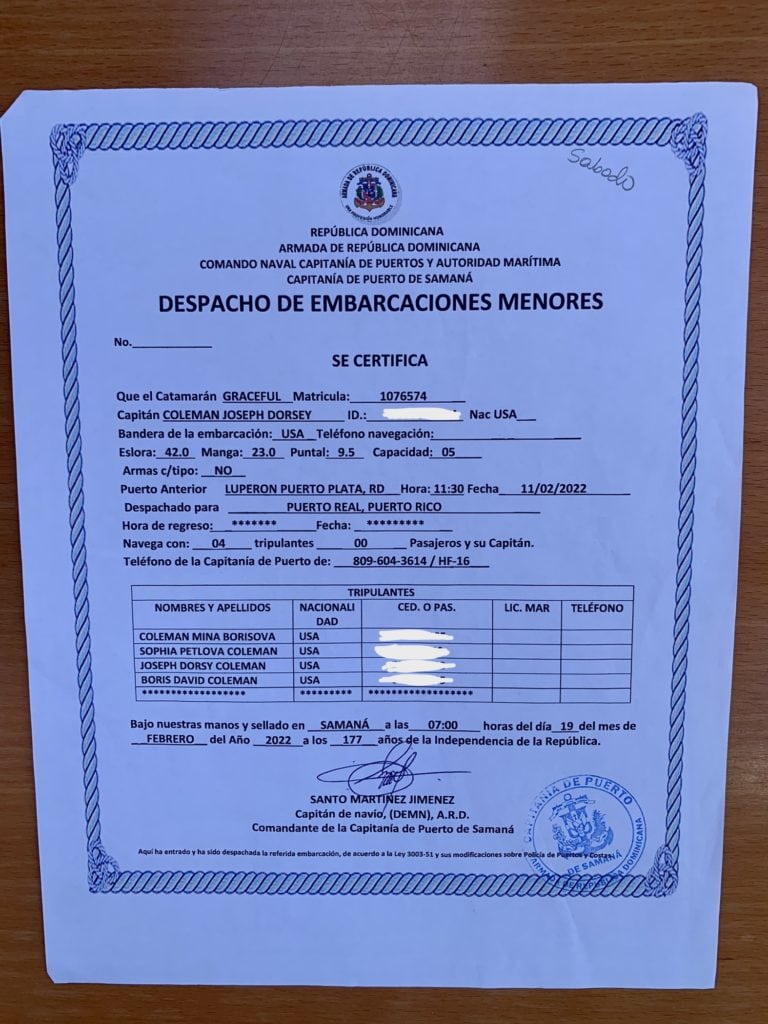
In addition to that, Saturday and Sunday are days off, so if one plans to leave on Saturday morning (like we did), one must obtain the “Dispacho” the evening before and then hope that the Armada guy shows up on time the next morning.
Plan for the Humpback Whales
Samana Bay is a gathering site for the humpback whales during January and February. Samana Bay is one of only few such sites around the world.
People from all over the world arrive to see the whales, and many tourist boats zoom around loaded with tourists, who hope to see, photograph and even touch the whales.
We were hoping to be able to see whales, but we were not planning on getting too close. We also wanted to make sure we could spot small boats, kayaks and fishermen, while still near the DR.
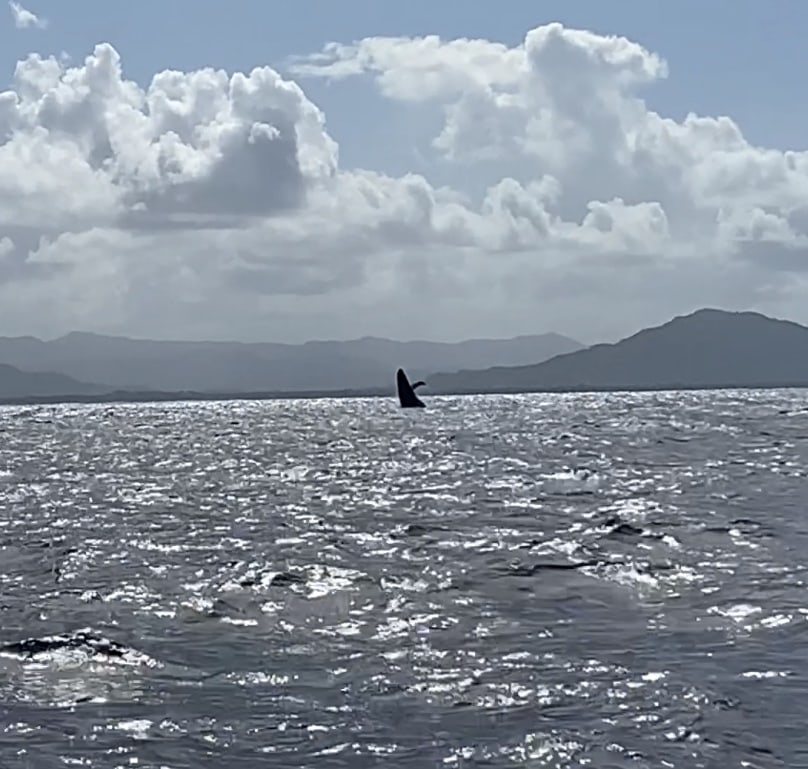
Is crossing the Mona Passage scary?
Was it a comfortable passage? No, it was not.
However, it was not scary, nor did we feel at risk at any point during it.
We have made and continue to make mistakes; we have had scary times at sea (like our electrical panel catching on fire, or exiting Fort Pierce Inlet), so I am far from thinking we are great sailors, but with enough research and some luck, things generally work out.
We have friends who started off just fine and then ripped a sail, broke an engine, or sustained some other kind of damage, which one cannot foresee. For anything that does not depend on us, we pray and hope for the best, it’s a humbling exercise…
After a challenging passage in the Dominican Republic, unexpected boat repairs, unnecessary bureaucracy and a long night on the Mona, the shores of Puerto Rico looked so comforting and welcoming in the rising sun!
And so did the casual announcement, “This is the United States Coast Guard, Puerto Rico. This is the United States Coast Guard, Puerto Rico. This is the United States Coast Guard, Puerto Rico. Break…”
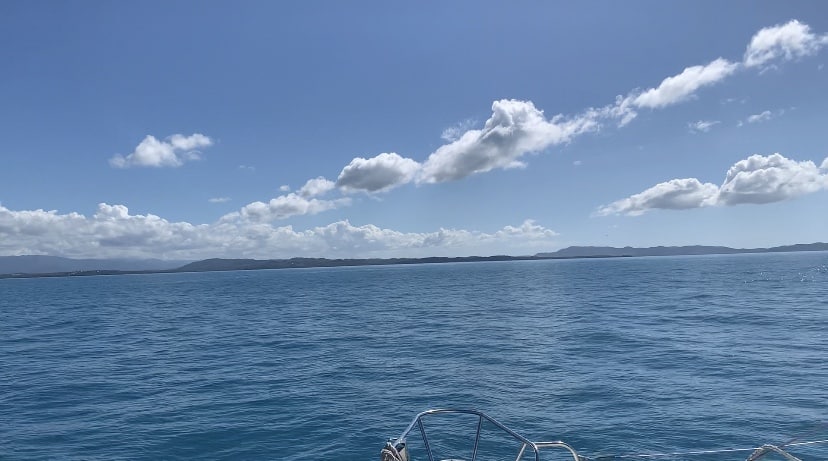
Remember to follow our journey in video, via our YouTube channel – Sailing Graceful! Also, go ahead and subscribe to our very exciting and very free blog! We even have a button for it – to starboard.
Related posts
Luperon the Locals’ Way. Guide to Luperon.
Darn it! I Failed Yoga, again! (In the Prettiest Gym on Earth!)
Dominican Republic Part 5 – Los Haitises, and a Decision, which Changed Everything!
A Very Embarrassing and Funny Waterfall Story

7 Comments